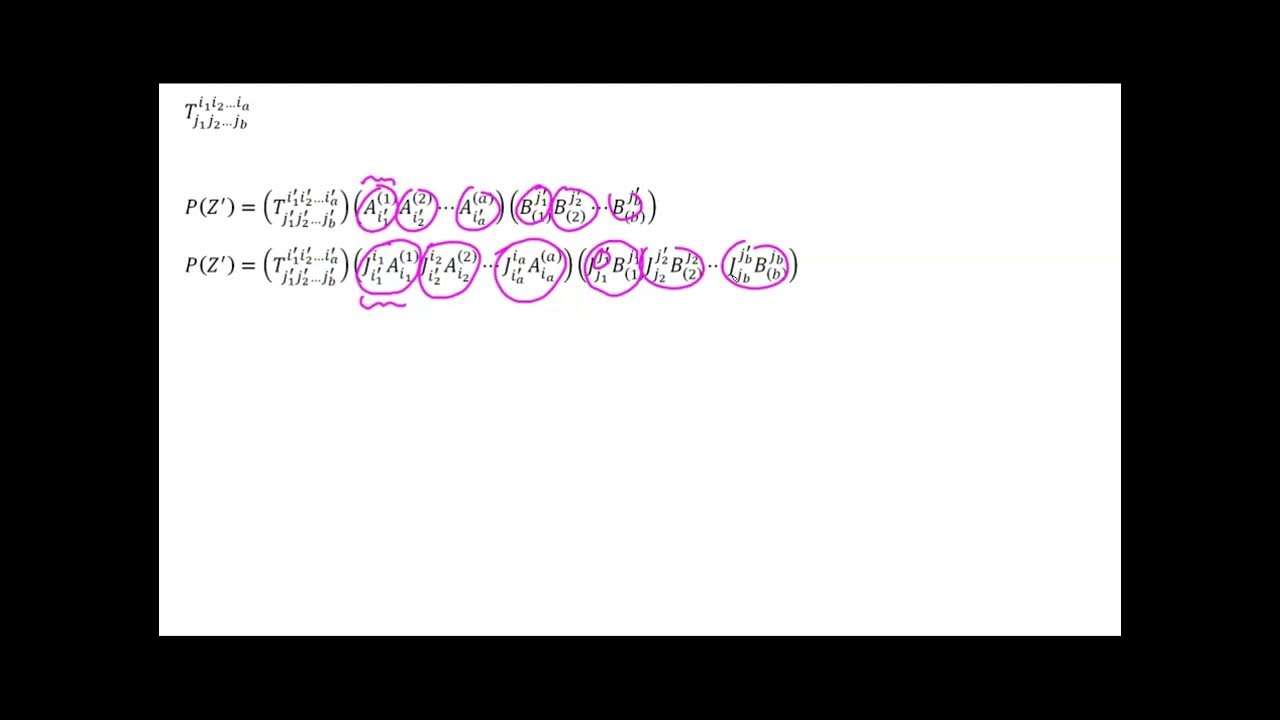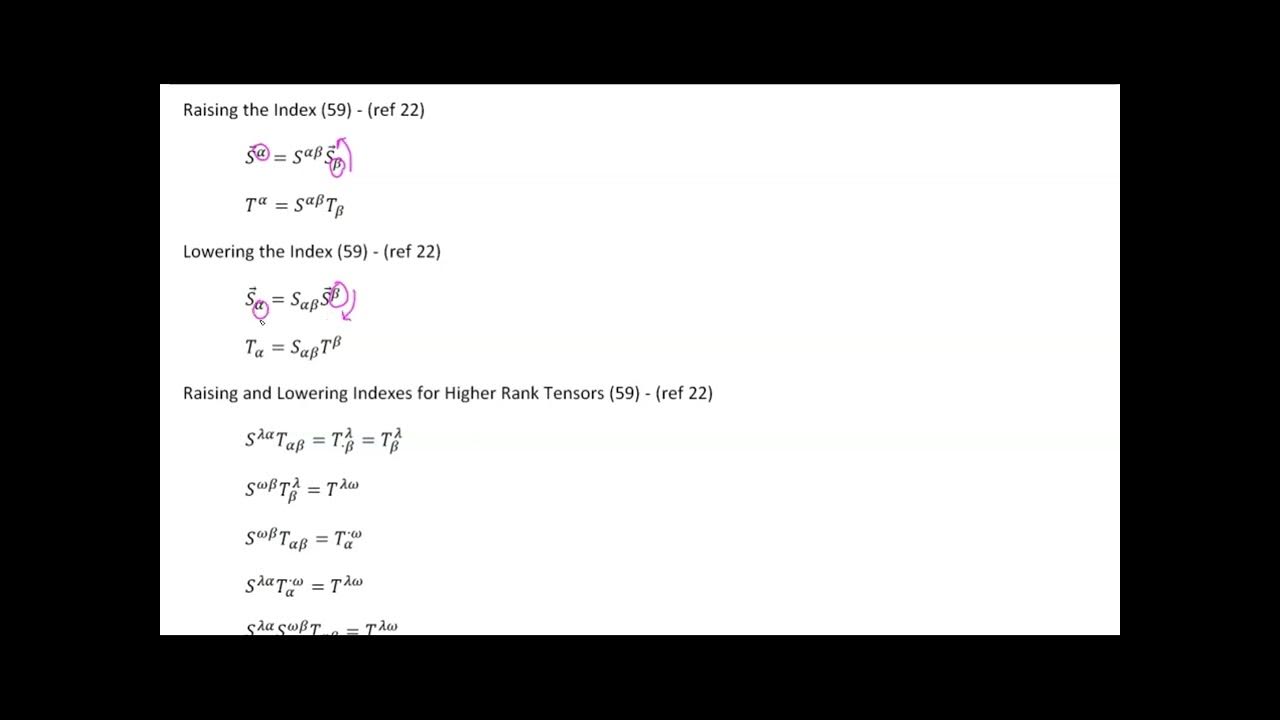Tensor Calculus For Physics Majors 007 | Metric Tensor pt. 2
TLDRThis episode of 'Tensor Calculus for Physics Majors' explores the application of the metric tensor in special relativity, introducing the concept of four vectors and their significance in space-time intervals. The video delves into the transformation properties of four vectors, particularly the four-velocity, and discusses the distinction between contravariant and covariant vectors. It also touches on the importance of upper and lower indices in tensor algebra and the implications for different geometries, setting the stage for further exploration of these concepts in future episodes.
Takeaways
- 📚 The video introduces the concept of the metric tensor and its application in special relativity, specifically in calculating the space-time interval.
- 🚀 The script explains how to construct a four-vector, which includes a temporal component and spatial components, to describe events in space-time.
- 🎯 The Minkowski metric is introduced, which is a diagonal matrix with a signature of '+---', reflecting the difference between space and time dimensions in special relativity.
- 🔍 The video discusses the transformation properties of four-vectors under Lorentz transformations, emphasizing the role of the gamma factor in preserving the four-vector nature.
- 🌀 The concept of four-velocity is explored, which is the derivative of space-time coordinates with respect to proper time, and is a key quantity in relativity.
- 📉 The script covers the distinction between contravariant and covariant vectors, explaining how they are related through the metric tensor and their transformation properties.
- 📚 The Einstein summation convention is explained, which simplifies the notation for summing over repeated indices in tensor expressions.
- 🔄 The video touches on the idea of dual vectors, which are related to contravariant vectors through the metric tensor and have different transformation properties.
- 📈 The gradient of a scalar function is discussed as an example of a covariant vector, showing how it transforms under coordinate changes.
- 🧠 The script hints at the broader implications of tensor calculus for fields like quantum mechanics, drawing parallels with concepts such as Hilbert spaces.
- 🔮 The video concludes by outlining the topics for the next episode, which will delve deeper into contravariant and covariant vectors, tensor algebra, and covariant derivatives.
Q & A
What is the metric tensor and how does it relate to squared distance in the context of the video?
-The metric tensor is a mathematical object that describes the geometry of a space, allowing one to calculate distances and angles. In the script, it is used to relate the squared distance to coordinate displacements by acting on these displacements, which is essential for understanding distances in curved spaces or relativistic scenarios.
How does the concept of a four-vector extend the idea of a displacement vector in special relativity?
-A four-vector in special relativity extends the displacement vector by adding a temporal component, making it a four-dimensional object that includes three spatial components and one temporal component. This allows for the description of events in space-time, where the separation between events can be both in space and time.
What is the significance of the space-time interval in the context of special relativity?
-The space-time interval is a measure of the 'distance' between two events in space-time that is invariant under Lorentz transformations. It is a key concept in special relativity, as it combines spatial and temporal separations into a single quantity that remains constant regardless of the observer's motion.
How is the metric tensor used to express the square of the proper time in terms of coordinate displacements?
-The square of the proper time can be expressed using the metric tensor by taking the dot product of the coordinate displacement vector with itself, weighted by the metric tensor. This results in an expression that combines the temporal and spatial components into a single scalar quantity representing the space-time interval.
What is the Minkowski metric and why is its signature important?
-The Minkowski metric is the metric tensor used in special relativity, which has a diagonal form with +1 for the temporal component and -1 for each of the spatial components. Its signature is important because it indicates the nature of the space-time geometry, distinguishing between time-like and space-like intervals.
What is a four-velocity and how does it relate to the concept of velocity in classical mechanics?
-A four-velocity is a four-vector that represents the velocity of an object in space-time. Unlike classical velocity, which is a vector in three-dimensional space, four-velocity incorporates both spatial velocity and the rate of change of time, making it a four-dimensional quantity that transforms according to the Lorentz transformation.
How does the Lorentz factor gamma relate to the four-velocity?
-The Lorentz factor gamma is the factor by which time dilation occurs in special relativity. It is used in the calculation of four-velocity, where the time component of the four-velocity is gamma times the velocity of the object in the spatial dimensions.
What is the difference between contravariant and covariant vectors, and why are they important in tensor calculus?
-Contravariant vectors have components with superscripts and transform according to the transformation rules of vectors, while covariant vectors have components with subscripts and transform according to the metric tensor. They are important in tensor calculus because they allow for the distinction between different types of vector spaces and transformations in curved or non-Euclidean geometries.
What is meant by the term 'dual vectors' in the context of the script?
-Dual vectors refer to the covariant vectors or components of one-forms, which are related to contravariant vectors through the metric tensor. They are the components of vectors with subscripts and are derived from the metric tensor, representing a different perspective on the vector space.
How does the gradient of a scalar field relate to the concept of covariant vectors?
-The gradient of a scalar field is a covariant vector, where each component represents the rate of change of the scalar field with respect to each coordinate. It is related to the concept of covariant vectors in that it demonstrates how such vectors can be constructed from the derivatives of scalar fields in a given coordinate system.
What is the significance of the Einstein summation convention in tensor calculus?
-The Einstein summation convention is a notational convention used in tensor calculus that implies summation over any index that appears twice, once as a subscript and once as a superscript. It simplifies the notation and makes the manipulation of tensor equations more efficient.
Outlines
📚 Introduction to Tensor Calculus and Special Relativity
This paragraph introduces the concept of tensor calculus, specifically focusing on the metric tensor and its application in physics. It explains how the metric tensor is used to calculate the squared distance in the context of special relativity, transitioning into a discussion of the space-time interval and four vectors. The paragraph sets the stage for further exploration of tensor calculus in the context of Lorentz transformations and the distinction between upper and lower indices in vectors.
🚀 Exploring Four Vectors and Velocity in Special Relativity
The second paragraph delves into the specifics of four vectors within the framework of special relativity. It discusses the transformation properties of four vectors, particularly the four-velocity, which is defined as the derivative of space-time coordinates with respect to proper time. The explanation clarifies the misconception of differentiating with respect to time alone and introduces the Lorentz factor, gamma, highlighting its role in maintaining the four-vector nature of velocity in different reference frames.
🔍 Understanding Upper and Lower Indices in Tensors
This paragraph examines the significance of upper and lower indices in tensors, especially in the context of the Minkowski metric used in special relativity. It explains how the metric's signature affects the scalar product and introduces the concept of contravariant and covariant vectors. The paragraph also discusses the transformation properties of these vectors and how they relate to the geometry of space-time, setting the stage for further exploration of tensor algebra and calculus.
🌐 Tensor Algebra and the Geometry of Space-Time
The final paragraph synthesizes the concepts introduced in the previous sections, focusing on tensor algebra and its implications for the geometry of space-time. It discusses the representation of vectors and their duals, the transformation of gradients, and the natural representation of vectors with subscript indices. The paragraph concludes with a preview of upcoming topics, including covariant derivatives and Christoffel symbols, indicating an eagerness to explore the deeper intricacies of tensor calculus in future discussions.
Mindmap
Keywords
💡Metric Tensor
💡Space-Time Interval
💡Four Vector
💡Lorentz Transformation
💡Proper Time
💡Covariant and Contravariant Vectors
💡Minkowski Metric
💡Einstein Summation Convention
💡Four Velocity
💡Gradient
Highlights
Introduction of the metric tensor and its relation to coordinate displacements in calculating squared distance.
Application of the metric tensor concept to special relativity within the space-time interval.
Discussion on four vectors and their significance in special relativity.
Explanation of the space-time interval and its components, including temporal and spatial parts.
Construction of the metric tensor for special relativity with a focus on its diagonal elements and signature.
Introduction to the concept of a four-velocity and its transformation properties.
Differentiation between contravariant and covariant vectors in the context of special relativity.
Derivation of the four-velocity expression using proper time and the Lorentz factor gamma.
Explanation of how the four-velocity components transform under Lorentz transformations.
Introduction to the concept of upper and lower indices in vectors and their physical interpretations.
Discussion on the transformation of vectors with subscript indices, specifically the gradient of a scalar function.
Connection between the space-time interval and the metric tensor using Einstein summation convention.
Insight into the distinction between contravariant and covariant vectors in different geometries.
Explanation of how the Minkowski metric's components affect the transformation of vectors.
Introduction to the concept of dual vectors and their relationship with contravariant vectors.
Discussion on the transformation rules for dual vectors and their significance in tensor algebra.
Connection between the gradient of a scalar function and the concept of covariant vectors.
Anticipation of future topics including covariant derivatives, Christoffel symbols, and tensor algebra.
Transcripts
5.0 / 5 (0 votes)
Thanks for rating:





